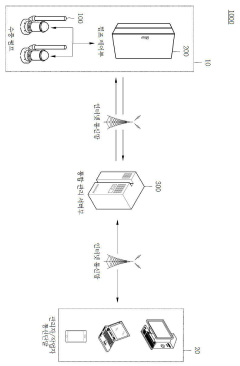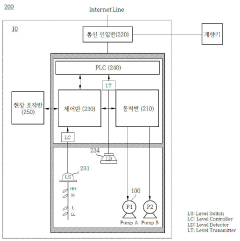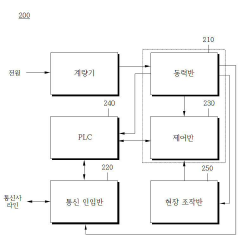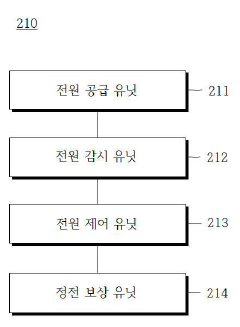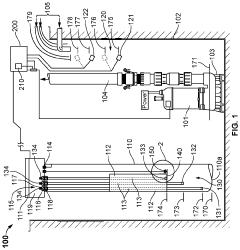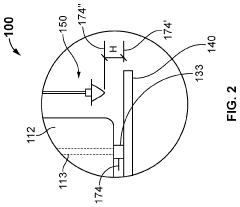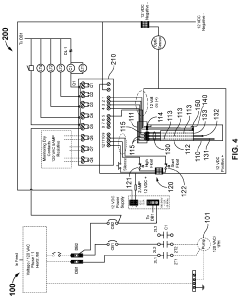Submersible pumps in remote sensing of underwater environments.
JUL 15, 20259 MIN READ
Generate Your Research Report Instantly with AI Agent
Patsnap Eureka helps you evaluate technical feasibility & market potential.
Underwater Pump Tech Evolution and Objectives
Submersible pumps have played a crucial role in underwater environments for decades, evolving from simple mechanical devices to sophisticated, sensor-equipped systems. The technology's progression has been driven by the increasing demand for efficient and reliable underwater operations in various industries, including offshore oil and gas, marine research, and environmental monitoring.
The evolution of submersible pump technology can be traced back to the early 20th century, with significant advancements occurring in the post-World War II era. Initially designed for dewatering and fluid transfer, these pumps have undergone substantial improvements in materials, design, and functionality. The introduction of corrosion-resistant alloys and advanced sealing technologies has greatly enhanced their durability and performance in harsh underwater conditions.
In recent years, the integration of remote sensing capabilities has marked a new frontier in submersible pump technology. This convergence has opened up unprecedented possibilities for real-time monitoring, data collection, and autonomous operation in underwater environments. The incorporation of sensors, such as pressure transducers, flow meters, and water quality analyzers, has transformed submersible pumps into multifunctional devices capable of providing valuable environmental data alongside their primary pumping functions.
The primary objectives of current research on submersible pumps in remote sensing of underwater environments are multifaceted. Firstly, there is a strong focus on improving energy efficiency and reducing the environmental impact of pump operations. This includes developing more efficient motor designs, optimizing impeller geometries, and exploring alternative power sources such as renewable energy.
Secondly, enhancing the reliability and longevity of submersible pumps in challenging underwater conditions remains a key goal. This involves research into advanced materials that can withstand high pressures, corrosive environments, and extreme temperatures. Additionally, the development of self-diagnostic and predictive maintenance capabilities is crucial for minimizing downtime and reducing operational costs.
Another significant objective is the advancement of remote sensing and data acquisition capabilities. This encompasses the integration of more sophisticated sensor arrays, improving data transmission technologies for real-time monitoring, and developing algorithms for automated data analysis and decision-making. The aim is to create intelligent pump systems that can adapt to changing environmental conditions and provide valuable insights for underwater research and operations.
Furthermore, there is a growing emphasis on the miniaturization and modularization of submersible pump systems. This trend is driven by the need for more versatile and easily deployable units, particularly in remote or hard-to-access underwater locations. Research is ongoing to develop compact, lightweight pumps that maintain high performance while offering greater flexibility in installation and maintenance.
The evolution of submersible pump technology can be traced back to the early 20th century, with significant advancements occurring in the post-World War II era. Initially designed for dewatering and fluid transfer, these pumps have undergone substantial improvements in materials, design, and functionality. The introduction of corrosion-resistant alloys and advanced sealing technologies has greatly enhanced their durability and performance in harsh underwater conditions.
In recent years, the integration of remote sensing capabilities has marked a new frontier in submersible pump technology. This convergence has opened up unprecedented possibilities for real-time monitoring, data collection, and autonomous operation in underwater environments. The incorporation of sensors, such as pressure transducers, flow meters, and water quality analyzers, has transformed submersible pumps into multifunctional devices capable of providing valuable environmental data alongside their primary pumping functions.
The primary objectives of current research on submersible pumps in remote sensing of underwater environments are multifaceted. Firstly, there is a strong focus on improving energy efficiency and reducing the environmental impact of pump operations. This includes developing more efficient motor designs, optimizing impeller geometries, and exploring alternative power sources such as renewable energy.
Secondly, enhancing the reliability and longevity of submersible pumps in challenging underwater conditions remains a key goal. This involves research into advanced materials that can withstand high pressures, corrosive environments, and extreme temperatures. Additionally, the development of self-diagnostic and predictive maintenance capabilities is crucial for minimizing downtime and reducing operational costs.
Another significant objective is the advancement of remote sensing and data acquisition capabilities. This encompasses the integration of more sophisticated sensor arrays, improving data transmission technologies for real-time monitoring, and developing algorithms for automated data analysis and decision-making. The aim is to create intelligent pump systems that can adapt to changing environmental conditions and provide valuable insights for underwater research and operations.
Furthermore, there is a growing emphasis on the miniaturization and modularization of submersible pump systems. This trend is driven by the need for more versatile and easily deployable units, particularly in remote or hard-to-access underwater locations. Research is ongoing to develop compact, lightweight pumps that maintain high performance while offering greater flexibility in installation and maintenance.
Market Analysis for Submersible Pump Remote Sensing
The market for submersible pumps in remote sensing of underwater environments has been experiencing significant growth in recent years, driven by increasing demand for underwater exploration, environmental monitoring, and offshore operations. This market segment combines the established submersible pump industry with cutting-edge remote sensing technologies, creating a niche but rapidly expanding sector.
The global submersible pump market, which forms the foundation for this specialized application, was valued at approximately $11.3 billion in 2020 and is projected to reach $15.8 billion by 2026, growing at a CAGR of 5.7% during the forecast period. Within this broader market, the segment dedicated to remote sensing applications is estimated to account for about 8-10% of the total market share, with potential for accelerated growth.
Key factors driving the demand for submersible pumps in remote sensing include the rising need for underwater data collection in oceanography, marine biology, and climate change studies. The offshore oil and gas industry also contributes significantly to market growth, as these pumps are essential for subsea operations and environmental monitoring around drilling sites.
Geographically, North America and Europe currently dominate the market due to their advanced technological infrastructure and substantial investments in marine research. However, the Asia-Pacific region is expected to witness the highest growth rate in the coming years, fueled by increasing maritime activities and growing awareness of ocean conservation.
The market is characterized by a high degree of technological innovation, with a focus on developing pumps that can operate at greater depths, withstand extreme pressures, and integrate seamlessly with advanced sensing and communication systems. This has led to the emergence of smart submersible pumps equipped with IoT capabilities, enabling real-time data transmission and remote operation.
Key challenges in the market include the high initial investment required for research and development, as well as the need for specialized skills in both pump technology and remote sensing. Additionally, the harsh underwater environment poses significant technical challenges, necessitating continuous innovation in materials and design.
Despite these challenges, the market outlook remains positive, with several growth opportunities on the horizon. The increasing adoption of autonomous underwater vehicles (AUVs) and remotely operated vehicles (ROVs) in various industries is expected to create new avenues for submersible pump applications in remote sensing. Furthermore, the growing focus on renewable energy, particularly offshore wind farms, is likely to boost demand for specialized submersible pumps for installation and maintenance operations.
The global submersible pump market, which forms the foundation for this specialized application, was valued at approximately $11.3 billion in 2020 and is projected to reach $15.8 billion by 2026, growing at a CAGR of 5.7% during the forecast period. Within this broader market, the segment dedicated to remote sensing applications is estimated to account for about 8-10% of the total market share, with potential for accelerated growth.
Key factors driving the demand for submersible pumps in remote sensing include the rising need for underwater data collection in oceanography, marine biology, and climate change studies. The offshore oil and gas industry also contributes significantly to market growth, as these pumps are essential for subsea operations and environmental monitoring around drilling sites.
Geographically, North America and Europe currently dominate the market due to their advanced technological infrastructure and substantial investments in marine research. However, the Asia-Pacific region is expected to witness the highest growth rate in the coming years, fueled by increasing maritime activities and growing awareness of ocean conservation.
The market is characterized by a high degree of technological innovation, with a focus on developing pumps that can operate at greater depths, withstand extreme pressures, and integrate seamlessly with advanced sensing and communication systems. This has led to the emergence of smart submersible pumps equipped with IoT capabilities, enabling real-time data transmission and remote operation.
Key challenges in the market include the high initial investment required for research and development, as well as the need for specialized skills in both pump technology and remote sensing. Additionally, the harsh underwater environment poses significant technical challenges, necessitating continuous innovation in materials and design.
Despite these challenges, the market outlook remains positive, with several growth opportunities on the horizon. The increasing adoption of autonomous underwater vehicles (AUVs) and remotely operated vehicles (ROVs) in various industries is expected to create new avenues for submersible pump applications in remote sensing. Furthermore, the growing focus on renewable energy, particularly offshore wind farms, is likely to boost demand for specialized submersible pumps for installation and maintenance operations.
Current Challenges in Underwater Remote Sensing
Underwater remote sensing faces several significant challenges that hinder its widespread adoption and effectiveness. One of the primary obstacles is the rapid attenuation of electromagnetic waves in water, which severely limits the range and resolution of traditional remote sensing techniques. This attenuation is particularly problematic for optical and radar-based systems, forcing researchers to explore alternative methods such as acoustic sensing.
The complex and dynamic nature of underwater environments presents another major challenge. Factors such as turbidity, varying salinity levels, and temperature gradients can significantly affect the propagation of signals and the quality of data collected. These environmental variables often change rapidly and unpredictably, making it difficult to maintain consistent and reliable sensing capabilities.
Power supply and data transmission pose substantial hurdles for underwater remote sensing systems. The harsh underwater environment limits the use of conventional power sources, necessitating the development of robust, long-lasting power solutions. Additionally, transmitting large volumes of data through water remains a significant technical challenge, often requiring the use of tethered systems or periodic surfacing of autonomous vehicles.
The corrosive nature of saltwater and high pressure at depth present durability issues for sensing equipment. Developing sensors and platforms that can withstand these conditions while maintaining accuracy and reliability is an ongoing challenge. This often results in increased costs and complexity of underwater sensing systems, limiting their widespread deployment.
Biofouling, the accumulation of microorganisms, plants, and animals on submerged surfaces, poses a significant problem for long-term deployment of underwater sensors. This biological growth can interfere with sensor readings and degrade equipment performance over time, necessitating frequent maintenance or the development of anti-fouling technologies.
Spatial and temporal coverage remain limited in underwater remote sensing compared to terrestrial or atmospheric sensing. The vast expanse of the world's oceans, combined with the technical limitations of underwater sensing systems, results in significant data gaps. Improving the range, endurance, and networking capabilities of underwater sensing platforms is crucial to addressing this challenge.
Finally, the integration and interpretation of data from multiple sensor types and platforms present significant data fusion and processing challenges. Developing algorithms and methodologies to effectively combine and analyze diverse datasets collected under varying conditions is essential for extracting meaningful insights from underwater remote sensing efforts.
The complex and dynamic nature of underwater environments presents another major challenge. Factors such as turbidity, varying salinity levels, and temperature gradients can significantly affect the propagation of signals and the quality of data collected. These environmental variables often change rapidly and unpredictably, making it difficult to maintain consistent and reliable sensing capabilities.
Power supply and data transmission pose substantial hurdles for underwater remote sensing systems. The harsh underwater environment limits the use of conventional power sources, necessitating the development of robust, long-lasting power solutions. Additionally, transmitting large volumes of data through water remains a significant technical challenge, often requiring the use of tethered systems or periodic surfacing of autonomous vehicles.
The corrosive nature of saltwater and high pressure at depth present durability issues for sensing equipment. Developing sensors and platforms that can withstand these conditions while maintaining accuracy and reliability is an ongoing challenge. This often results in increased costs and complexity of underwater sensing systems, limiting their widespread deployment.
Biofouling, the accumulation of microorganisms, plants, and animals on submerged surfaces, poses a significant problem for long-term deployment of underwater sensors. This biological growth can interfere with sensor readings and degrade equipment performance over time, necessitating frequent maintenance or the development of anti-fouling technologies.
Spatial and temporal coverage remain limited in underwater remote sensing compared to terrestrial or atmospheric sensing. The vast expanse of the world's oceans, combined with the technical limitations of underwater sensing systems, results in significant data gaps. Improving the range, endurance, and networking capabilities of underwater sensing platforms is crucial to addressing this challenge.
Finally, the integration and interpretation of data from multiple sensor types and platforms present significant data fusion and processing challenges. Developing algorithms and methodologies to effectively combine and analyze diverse datasets collected under varying conditions is essential for extracting meaningful insights from underwater remote sensing efforts.
Existing Submersible Pump Remote Sensing Solutions
01 Design and construction of submersible pumps
This category focuses on the structural aspects and design innovations of submersible pumps. It includes improvements in pump housing, impeller design, and overall construction to enhance efficiency and durability in submerged environments. These advancements aim to optimize pump performance, increase reliability, and extend operational life in various underwater applications.- Design improvements for submersible pumps: Various design improvements have been made to enhance the performance and efficiency of submersible pumps. These include modifications to the pump structure, impeller design, and motor configuration to optimize fluid flow, increase durability, and improve overall pump efficiency in submerged conditions.
- Control systems for submersible pumps: Advanced control systems have been developed for submersible pumps to enhance their operation and monitoring capabilities. These systems may include sensors, data analysis tools, and remote monitoring features to optimize pump performance, detect faults, and enable predictive maintenance.
- Energy-efficient submersible pump technologies: Innovations in submersible pump technology have focused on improving energy efficiency. This includes the development of high-efficiency motors, variable speed drives, and optimized hydraulic designs to reduce power consumption while maintaining or improving pump performance.
- Specialized submersible pumps for specific applications: Submersible pumps have been designed for specific applications such as oil and gas extraction, wastewater treatment, and deep-sea operations. These specialized pumps incorporate features tailored to their intended use, such as corrosion-resistant materials, high-pressure capabilities, or the ability to handle abrasive fluids.
- Historical developments in submersible pump technology: The evolution of submersible pump technology can be traced through historical patents, showcasing early innovations and fundamental design principles. These developments have laid the foundation for modern submersible pump designs and continue to influence current technological advancements in the field.
02 Control systems for submersible pumps
This area covers the development of advanced control systems for submersible pumps. It includes innovations in monitoring, automation, and remote operation capabilities. These systems aim to improve pump efficiency, prevent failures, and enable real-time adjustments based on operating conditions, enhancing overall performance and reliability of submersible pump installations.Expand Specific Solutions03 Energy efficiency in submersible pumps
This category addresses innovations aimed at improving the energy efficiency of submersible pumps. It includes advancements in motor design, power management systems, and hydraulic optimizations. These developments focus on reducing power consumption while maintaining or improving pump performance, contributing to more sustainable and cost-effective pump operations.Expand Specific Solutions04 Specialized submersible pumps for specific applications
This area covers the development of submersible pumps tailored for specific industries or environments. It includes pumps designed for oil and gas extraction, wastewater treatment, mining operations, and deep-sea applications. These specialized pumps feature unique characteristics to meet the challenges of their intended use, such as handling abrasive materials, corrosive fluids, or extreme pressures.Expand Specific Solutions05 Maintenance and reliability improvements for submersible pumps
This category focuses on innovations that enhance the reliability and ease of maintenance of submersible pumps. It includes advancements in seal technology, bearing designs, and modular construction approaches. These improvements aim to extend pump lifespan, reduce downtime, and simplify repair and maintenance procedures, ultimately lowering the total cost of ownership for submersible pump systems.Expand Specific Solutions
Key Players in Underwater Sensing Industry
The research on submersible pumps in remote sensing of underwater environments is in a growth phase, with increasing market size due to expanding applications in oceanography, offshore energy, and environmental monitoring. The global submersible pump market is projected to reach significant value in the coming years, driven by technological advancements and growing demand for underwater exploration. Companies like Schlumberger Technologies, Baker Hughes, and Woods Hole Oceanographic Institution are at the forefront of developing advanced submersible pump technologies for remote sensing applications. The technology's maturity varies, with established players like Grundfos and Flowserve offering reliable solutions, while newer entrants like VOYIS Imaging are introducing innovative optical systems for underwater data collection, indicating a dynamic and evolving competitive landscape.
Schlumberger Technologies, Inc.
Technical Solution: Schlumberger has developed advanced submersible pump systems for underwater remote sensing applications. Their technology integrates high-pressure tolerant sensors and robust telemetry systems to operate in extreme depths. The company's submersible pumps feature real-time data transmission capabilities, allowing for continuous monitoring of underwater environments. Schlumberger's pumps are equipped with advanced flow control mechanisms that adjust to varying underwater conditions, ensuring optimal performance and data collection[1]. The pumps also incorporate corrosion-resistant materials and self-diagnostic systems to enhance longevity and reliability in harsh subsea environments[3].
Strengths: Industry-leading expertise in subsea technologies, global presence, and extensive R&D capabilities. Weaknesses: High costs associated with advanced technologies, potential over-reliance on oil and gas industry.
Baker Hughes Co.
Technical Solution: Baker Hughes has innovated in submersible pump technology for underwater remote sensing with their Centrilift™ series. These pumps feature advanced sensors capable of measuring various parameters such as pressure, temperature, and fluid composition in real-time. The company's pumps utilize artificial intelligence algorithms to optimize performance based on environmental conditions[2]. Baker Hughes has also developed a unique power and communication system that allows for extended operation and data transmission in deep-sea environments. Their pumps incorporate modular designs, enabling easy maintenance and upgrades without full system replacement[4].
Strengths: Strong focus on digital solutions and AI integration, extensive experience in offshore operations. Weaknesses: Complex systems may require specialized training for operation and maintenance.
Core Innovations in Underwater Pump Sensing
Remote control system having pump controller mountable in water structure
PatentActiveKR1020230034651A
Innovation
- A remote control system with a pump control panel installed in the water structure that monitors and manages submersible pumps via an internet communication line, utilizing a pump control unit, power panel, PLC, and integrated management server to detect operational states, generate alarms, and provide real-time data monitoring and management.
Submersible pump detection system
PatentInactiveUS20230160389A1
Innovation
- The system employs a stilling tube to reduce turbulence, combined with sensors and a programmable logic controller (PLC) to accurately detect hydrocarbon layers, using optical and conductivity sensors, and includes a sensing plate for precise readings, along with a variable frequency drive to control the pump and activate alarms for contaminant presence.
Environmental Impact of Underwater Sensing Systems
The deployment of underwater sensing systems, including submersible pumps for remote sensing, has significant environmental implications that must be carefully considered. These systems, while crucial for scientific research and resource management, can potentially disrupt marine ecosystems if not implemented thoughtfully.
One of the primary concerns is the physical presence of sensing equipment in underwater environments. Submersible pumps and associated sensors may alter local habitats, potentially affecting marine life behavior and distribution patterns. The installation process itself can cause temporary disturbances to the seabed, potentially damaging benthic communities or sensitive coral reefs.
Noise pollution is another critical factor to consider. Submersible pumps and other underwater sensing devices often generate low-frequency sounds that can travel long distances in water. This anthropogenic noise may interfere with marine animal communication, navigation, and feeding behaviors, particularly affecting species that rely heavily on acoustic signals, such as cetaceans and certain fish species.
The introduction of foreign materials into marine environments is also a concern. Sensors and pumps may leach chemicals or shed microplastics over time, contributing to water pollution. Additionally, if not properly maintained or retrieved, these systems could become marine debris, further exacerbating the global problem of ocean pollution.
Energy consumption is another environmental consideration. While many underwater sensing systems are designed to be energy-efficient, the cumulative power requirements for large-scale deployments could be substantial. This raises questions about the carbon footprint associated with powering these systems, especially if non-renewable energy sources are used.
On the positive side, underwater sensing systems can play a crucial role in environmental monitoring and conservation efforts. By providing real-time data on water quality, temperature, and marine life movements, these systems enable scientists and policymakers to make informed decisions about marine resource management and protection.
To mitigate potential negative impacts, it is essential to adopt environmentally conscious design principles for underwater sensing systems. This includes using eco-friendly materials, implementing noise reduction technologies, and developing efficient power systems. Additionally, careful site selection and installation procedures can minimize habitat disruption.
In conclusion, while underwater sensing systems offer valuable benefits for marine research and management, their environmental impact must be carefully assessed and mitigated. Balancing the need for data collection with ecosystem preservation requires ongoing research, innovative design solutions, and adherence to best practices in marine environmental stewardship.
One of the primary concerns is the physical presence of sensing equipment in underwater environments. Submersible pumps and associated sensors may alter local habitats, potentially affecting marine life behavior and distribution patterns. The installation process itself can cause temporary disturbances to the seabed, potentially damaging benthic communities or sensitive coral reefs.
Noise pollution is another critical factor to consider. Submersible pumps and other underwater sensing devices often generate low-frequency sounds that can travel long distances in water. This anthropogenic noise may interfere with marine animal communication, navigation, and feeding behaviors, particularly affecting species that rely heavily on acoustic signals, such as cetaceans and certain fish species.
The introduction of foreign materials into marine environments is also a concern. Sensors and pumps may leach chemicals or shed microplastics over time, contributing to water pollution. Additionally, if not properly maintained or retrieved, these systems could become marine debris, further exacerbating the global problem of ocean pollution.
Energy consumption is another environmental consideration. While many underwater sensing systems are designed to be energy-efficient, the cumulative power requirements for large-scale deployments could be substantial. This raises questions about the carbon footprint associated with powering these systems, especially if non-renewable energy sources are used.
On the positive side, underwater sensing systems can play a crucial role in environmental monitoring and conservation efforts. By providing real-time data on water quality, temperature, and marine life movements, these systems enable scientists and policymakers to make informed decisions about marine resource management and protection.
To mitigate potential negative impacts, it is essential to adopt environmentally conscious design principles for underwater sensing systems. This includes using eco-friendly materials, implementing noise reduction technologies, and developing efficient power systems. Additionally, careful site selection and installation procedures can minimize habitat disruption.
In conclusion, while underwater sensing systems offer valuable benefits for marine research and management, their environmental impact must be carefully assessed and mitigated. Balancing the need for data collection with ecosystem preservation requires ongoing research, innovative design solutions, and adherence to best practices in marine environmental stewardship.
Underwater Communication Protocols for Remote Sensing
Underwater communication protocols play a crucial role in remote sensing applications for submersible pumps in underwater environments. These protocols enable efficient data transmission between submerged sensors, pumps, and surface-level control stations. The choice of communication protocol significantly impacts the overall performance and reliability of underwater remote sensing systems.
Acoustic communication is the most widely used method for underwater data transmission. It utilizes sound waves to propagate information through water, offering longer range compared to other methods. However, acoustic signals are subject to multipath propagation, Doppler effects, and ambient noise, which can affect data integrity. To address these challenges, various acoustic protocols have been developed, such as frequency-hopping spread spectrum (FHSS) and direct sequence spread spectrum (DSSS). These techniques enhance signal robustness and improve data transmission reliability in challenging underwater conditions.
Optical communication is another promising approach for short-range, high-bandwidth underwater data transfer. It employs visible or near-infrared light to transmit information, offering higher data rates compared to acoustic methods. However, optical signals are limited by water turbidity and ambient light interference. Protocols like pulse position modulation (PPM) and on-off keying (OOK) are commonly used in underwater optical communication systems to optimize signal transmission and reception.
Radio frequency (RF) communication, while limited in range underwater, can be effective for short-distance, high-speed data transfer. RF protocols such as ZigBee and Bluetooth have been adapted for underwater use, particularly in shallow water environments or for communication between submerged devices and surface buoys.
Hybrid communication systems that combine multiple protocols are gaining traction in underwater remote sensing applications. These systems leverage the strengths of different communication methods to optimize data transmission across varying underwater conditions. For instance, a hybrid acoustic-optical system might use acoustic signals for long-range communication and switch to optical transmission for high-speed data transfer when devices are in close proximity.
Protocol selection for underwater remote sensing of submersible pumps depends on various factors, including water depth, turbidity, required data rate, and power constraints. Adaptive protocols that can dynamically adjust transmission parameters based on environmental conditions are particularly valuable in this context. These protocols can optimize communication performance by selecting the most appropriate modulation scheme, frequency band, or transmission power level in real-time.
As research in underwater communication continues to advance, new protocols are emerging to address the unique challenges of this environment. These include cognitive protocols that can sense and adapt to changing channel conditions, as well as cooperative protocols that leverage multiple nodes to improve overall network performance and reliability.
Acoustic communication is the most widely used method for underwater data transmission. It utilizes sound waves to propagate information through water, offering longer range compared to other methods. However, acoustic signals are subject to multipath propagation, Doppler effects, and ambient noise, which can affect data integrity. To address these challenges, various acoustic protocols have been developed, such as frequency-hopping spread spectrum (FHSS) and direct sequence spread spectrum (DSSS). These techniques enhance signal robustness and improve data transmission reliability in challenging underwater conditions.
Optical communication is another promising approach for short-range, high-bandwidth underwater data transfer. It employs visible or near-infrared light to transmit information, offering higher data rates compared to acoustic methods. However, optical signals are limited by water turbidity and ambient light interference. Protocols like pulse position modulation (PPM) and on-off keying (OOK) are commonly used in underwater optical communication systems to optimize signal transmission and reception.
Radio frequency (RF) communication, while limited in range underwater, can be effective for short-distance, high-speed data transfer. RF protocols such as ZigBee and Bluetooth have been adapted for underwater use, particularly in shallow water environments or for communication between submerged devices and surface buoys.
Hybrid communication systems that combine multiple protocols are gaining traction in underwater remote sensing applications. These systems leverage the strengths of different communication methods to optimize data transmission across varying underwater conditions. For instance, a hybrid acoustic-optical system might use acoustic signals for long-range communication and switch to optical transmission for high-speed data transfer when devices are in close proximity.
Protocol selection for underwater remote sensing of submersible pumps depends on various factors, including water depth, turbidity, required data rate, and power constraints. Adaptive protocols that can dynamically adjust transmission parameters based on environmental conditions are particularly valuable in this context. These protocols can optimize communication performance by selecting the most appropriate modulation scheme, frequency band, or transmission power level in real-time.
As research in underwater communication continues to advance, new protocols are emerging to address the unique challenges of this environment. These include cognitive protocols that can sense and adapt to changing channel conditions, as well as cooperative protocols that leverage multiple nodes to improve overall network performance and reliability.
Unlock deeper insights with Patsnap Eureka Quick Research — get a full tech report to explore trends and direct your research. Try now!
Generate Your Research Report Instantly with AI Agent
Supercharge your innovation with Patsnap Eureka AI Agent Platform!
